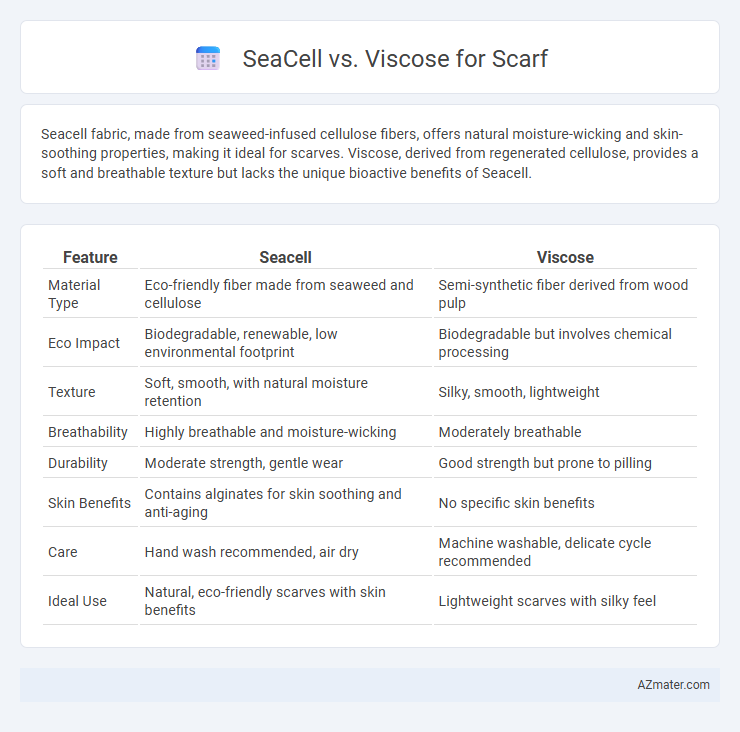Seacell fabric, made from seaweed-infused cellulose fibers, offers natural moisture-wicking and skin-soothing properties, making it ideal for scarves. Viscose, derived from regenerated cellulose, provides a soft and breathable texture but lacks the unique bioactive benefits of Seacell.
Table of Comparison
| Feature | Seacell | Viscose |
|---|---|---|
| Material Type | Eco-friendly fiber made from seaweed and cellulose | Semi-synthetic fiber derived from wood pulp |
| Eco Impact | Biodegradable, renewable, low environmental footprint | Biodegradable but involves chemical processing |
| Texture | Soft, smooth, with natural moisture retention | Silky, smooth, lightweight |
| Breathability | Highly breathable and moisture-wicking | Moderately breathable |
| Durability | Moderate strength, gentle wear | Good strength but prone to pilling |
| Skin Benefits | Contains alginates for skin soothing and anti-aging | No specific skin benefits |
| Care | Hand wash recommended, air dry | Machine washable, delicate cycle recommended |
| Ideal Use | Natural, eco-friendly scarves with skin benefits | Lightweight scarves with silky feel |
Introduction to Seacell and Viscose
Seacell is a sustainable fabric made by combining seaweed with cellulose fibers, renowned for its skin-friendly properties and environmental benefits. Viscose, derived from regenerated cellulose typically sourced from wood pulp, offers softness and breathability but involves a more chemically intensive production process. Both materials are popular choices for scarves due to their lightweight texture, with Seacell favored for its eco-conscious appeal and Viscose valued for its smooth drape.
What is Seacell Fabric?
Seacell fabric is an innovative textile made by blending cellulose fibers with sustainably harvested seaweed, offering natural skin-soothing properties and enhanced moisture retention. Unlike viscose, which is derived from chemically processed wood pulp, Seacell provides eco-friendly benefits and bioactive elements that support skin health during wear. This makes Seacell an ideal choice for scarves seeking a combination of comfort, sustainability, and functional skincare benefits.
Understanding Viscose Material
Viscose, a semi-synthetic fiber made from regenerated cellulose, offers a smooth, silk-like texture and excellent breathability, making it a popular choice for scarves. Compared to Seacell, which integrates seaweed fibers for added skin benefits, viscose provides superior moisture absorption and vibrant dye retention. Understanding viscose's eco-friendly production process and versatile fabric qualities helps in choosing scarves that combine comfort, style, and sustainability.
Production Process: Seacell vs Viscose
Seacell production involves embedding sustainably harvested seaweed into regenerated cellulose fibers through an eco-friendly process that preserves the seaweed's natural nutrients. In contrast, viscose is produced by chemically treating wood pulp with sodium hydroxide and carbon disulfide, resulting in a heavily industrial process with higher environmental impact. The biodegradability and skin-beneficial properties of Seacell fibers differentiate it substantially from the chemically intensive viscose manufacturing.
Sustainability and Environmental Impact
Seacell scarves are crafted from seaweed-infused fibers, promoting sustainability through biodegradable materials and regenerative ocean resources, which significantly reduce environmental impact. Viscose scarves, although derived from natural cellulose, often involve intensive chemical processing and deforestation, raising concerns about their ecological footprint. Choosing Seacell over viscose enhances eco-friendly fashion choices by minimizing pollution and supporting renewable resource cycles.
Comfort and Softness Comparison
Seacell fibers, derived from seaweed and cellulose, provide superior moisture absorption and natural skin-soothing properties, making scarves exceptionally comfortable and gentle. Viscose, manufactured from regenerated cellulose, offers a smooth, silk-like texture but tends to retain less moisture and can feel less breathable compared to Seacell. The inherent antibacterial benefits of Seacell enhance softness over time by reducing odor, while Viscose scarves may require more careful maintenance to preserve their comfort.
Breathability and Moisture Management
Seacell fabric, infused with seaweed fibers, offers superior breathability compared to viscose, promoting better air circulation for a comfortable scarf experience. Its natural moisture-wicking properties efficiently manage perspiration and humidity, keeping the skin dry and fresh. Viscose, although soft and smooth, tends to retain moisture longer, making Seacell the preferred choice for enhanced moisture management and breathability in scarves.
Durability and Longevity
Seacell fibers, derived from seaweed and cellulose, offer superior durability compared to viscose, resisting wear and tear while maintaining softness. Viscose, though smooth and breathable, tends to weaken with repeated use and washing due to its regenerated cellulose structure. Scarves made from Seacell demonstrate enhanced longevity, retaining fiber integrity and appearance over time better than viscose alternatives.
Skin Benefits for Scarf Wearers
Seacell fibers, derived from seaweed and cellulose, offer natural skin benefits such as moisturizing properties and antioxidant effects, making scarves made from Seacell ideal for sensitive or dry skin. In contrast, viscose, a regenerated cellulose fiber, provides softness and breathability but lacks the unique bioactive compounds found in Seacell that actively promote skin health. Scarves crafted from Seacell support skin hydration and protection, distinguishing them from traditional viscose scarves primarily valued for comfort rather than dermatological advantages.
Which is Better for Scarves: Seacell or Viscose?
Seacell fabric, infused with seaweed fibers, offers natural moisture retention, biodegradability, and skin-soothing properties, making it ideal for scarves that prioritize sustainability and comfort. Viscose, a semi-synthetic fiber derived from wood pulp, boasts a soft, silky texture and excellent drape but may lack eco-friendliness due to chemical processing. For scarves, Seacell is better suited when seeking a blend of softness, eco-consciousness, and skin benefits, whereas Viscose excels in affordability and vibrant color retention.

Infographic: Seacell vs Viscose for Scarf
 azmater.com
azmater.com